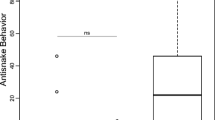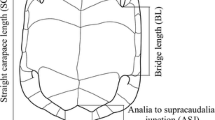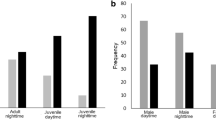Abstract
Newborn offspring of animals often exhibit fully functional innate antipredator behaviors, but they may also require learning or further development to acquire appropriate responses. Experience allows offspring to modify responses to specific threats and also leaves them vulnerable during the learning period. However, antipredator behaviors used at one stage of a predator encounter may compensate for deficiencies at another stage, a phenomenon that may reduce the overall risk of young that are vulnerable at one or more stages. Few studies have examined age differences in the effectiveness of antipredator behaviors across multiple stages of a predator encounter. In this study, we examined age differences in the antipredator behaviors of California ground squirrels (Otospermophilus beecheyi) during the detection, interaction, and attack stages of Pacific rattlesnake (Crotalus oreganus) encounters. Using free-ranging squirrels, we examined the ability to detect free-ranging rattlesnakes, snake-directed behaviors after discovery of a snake, and responses to simulated rattlesnake strikes. We found that age was the most important factor in snake detection, with adults being more likely to detect snakes than pups. We also found that adults performed more tail flagging (a predator-deterrent signal) toward snakes and were more likely to investigate a snake’s refuge when interacting with a hidden snake. In field experiments simulating snake strikes, adults exhibited faster reaction times than pups. Our results show that snake detection improves with age and that pups probably avoid rattlesnakes and minimize time spent in close proximity to them to compensate for their reduced reaction times to strikes.


Similar content being viewed by others
References
Abramsky Z, Rosenzweig ML, Subach A (1997) Gerbils under threat of owl predation: isoclines and isodars. Oikos 78:81–90
Abramsky Z, Rosenzweig ML, Subach A (2002) The costs of apprehensive foraging. Ecology 83:1330–1340
Alberts JR, Cramer CP (1988) Ecology and experience: sources of means and meaning of developmental change. In: Blass EM (ed) Developmental psychobiology and behavioral ecology. Plenum Press, New York, pp 1–39
Arenz C, Leger D (2000) Antipredator vigilance of juvenile and adult thirteen-lined ground squirrels and the role of nutritional need. Anim Behav 59:535–541
Barbour MA, Clark RW (2012) Ground squirrel tail-flag displays alter both predatory strike and ambush site selection behaviours of rattlesnakes. Proc R Soc Lond B 279:3827–3833
Boellstorff DE, Owings DH (1995) Home range, population structure, and spatial organization of California ground squirrels. J Mammal 76:551–561
Bouskila A (1995) Interactions between predation risk and competition: a field study of kangaroo rats and snakes. Ecology 76:165–178
Broom M, Ruxton GD (2012) Perceptual advertisement by the prey of stalking or ambushing predators. J Theor Biol 315:9–16
Caro TM, FitzGibbon CD (1992) Large carnivores and their prey: die quick and die dead. In: Crawtey MJ (ed) Natural enemies: the population biology of predators. Parasites and diseases. Blackwell Scientific, Oxford, pp 117–142
Carrier R (1996) Ontogenetic limits on locomotor performance. Physiol Zool 69:467–488
Clark RW (2004) Timber rattlesnakes (Crotalus horridus) use chemical cues to select ambush sites. J Chem Ecol 30:607–617
Clark RW, Tangco S, Barbour MA (2012) Field video recordings reveal factors influencing predatory strike success of free-ranging rattlesnakes (Crotalus spp.). Anim Behav 84:183–190
Cook M, Mineka S (1987) Second-order conditioning and overshadowing in the observational conditioning of fear in monkeys. Behav Res Ther 25:349–364
Correa HKM, Coutinho PEG (1997) Fatal attack of a pit viper, Bothrops jararaca, on an infant buffy-tufted ear marmoset (Callithrix aurita). Primates 38:215–217
Coss RG (1991) Context and animal behavior III: the relationship between early development and evolutionary persistence of ground squirrel antisnake behavior. Ecol Psychol 3:277–315
Cresswell W (1994) Song as a pursuit-deterrent signal, and its occurrence relative to other anti-predation behaviors of skylark (Alauda arvensis) on attack by merlins (Falco columbarius). Behav Ecol Sociobiol 34:217–223
Devereux CL (2005) Predator detection and avoidance by starlings under differing scenarios of predation risk. Behav Ecol 17:303–309
Dixon SM, Baker RL (1988) Effects of size on predation risk, behavioural response to fish, and cost of reduced feeding in larval Ischnura verticalis (Coenagrionidae: Odonata). Oecologia 76:200–205
Embar K, Raveh A, Hoffmann I, Kotler BP (2014) Predator facilitation or interference: a game of vipers and owls. Oecologia 174:1301–1309
Fitch HS (1949) Study of snake populations in central California. Am Midl Nat 41:513–579
FitzGibbon CD (1994) The costs and benefits of predator inspection behaviour in Thomson’s gazelles. Anim Behav 34:139–148
FitzGibbon CD, Fanshawe JH (1988) Stotting in Thomson’s gazelles: an honest signal of condition. Behav Ecol Sociobiol 23:69–74
Griffin AS (2004) Social learning about predators: a review and prospectus. Anim Learn Behav 32:131–140
Hanson MT, Coss RG (1997) Age differences in the response of California ground squirrels (Spermophilus beecheyi) to avian and mammalian predators. J Comp Psychol 111:174–84
Hanson MT, Coss RG (2001) Age differences in arousal and vigilance in California ground squirrels (Spermophilus beecheyi). Dev Psychobiol 39:199–206
Hasson O (1991) Pursuit-deterrent signals: communication between prey and predator. Trends Ecol Evol 6:325–329
Hawlena D (2009) Colorful tails fade when lizards adopt less risky behaviors. Behav Ecol Sociobiol 64:205–213
Hawlena D, Boochnik R, Abramsky Z, Bouskila A (2006) Blue tail and striped body: why do lizards change their infant costume when growing up? Behav Ecol 17:889–896
Hennessy DF, Owings DH (1977) Snake species discrimination and the role of olfactory cues in the snake-directed behavior of the California ground squirrel. Behaviour 65:115–123
Hennessy F, Owings H (1988) Rattlesnakes create a context for localizing their search for potential prey. Ethology 77:317–329
Hersek MJ (1990) Behavior of predator and prey in a highly coevolved system: northern Pacific rattlesnakes and California ground squirrels. Thesis, University of California, Davis
Hersek MJ, Owings DH (1993) Tail flagging by adult California ground squirrels: a tonic signal that serves different functions for males and females. Anim Behav 46:129–138
Hersek M, Owings DH (1994) Tail flagging by young California ground squirrels, Spermophilus beecheyi: age-specific participation in a tonic communicative system. Anim Behav 48:803–811
Heyes CM (1994) Social learning in animals: categories and mechanisms. Biol Rev 69:207–231
Hileman KS, Brodie ED Jr (1994) Survival strategies of the salamander Desmognathus ochrophaeus: interaction of predator-avoidance and anti-predator mechanisms. Anim Behav 47:1–6
Hollén LI, Manser MB (2006) Ontogeny of alarm call responses in meerkats, Suricata suricatta: the roles of age, sex and nearby conspecifics. Anim Behav 72:1345–1353
Hopkins GR, Gall BG, Brodie ED Jr (2011) Ontogenetic shift in efficacy of antipredator mechanisms in a top aquatic predator, Anax junius (Odonata: Aeshnidae). Ethology 117:1093–1100
Jones KA, Krebs JR, Whittingham MJ (2009) Heavier birds react faster to predators: individual differences in the detection of stalking and ambush predators. Behav Ecol Sociobiol 63:1319–1329
Kehmeier S, Schloegl C, Scheiber IBR, Weiß BM (2011) Early development of gaze following into distant space in juvenile Greylag geese (Anser anser). Anim Cogn 14:477–485
Kotler BP, Blaustein L, Brown JS (1992) Predator facilitation: the combined effect of snakes and owls on the foraging behavior of gerbils. Ann Zool Fenn 29:199–206
Kotler BP, Brown JS, Dall SRX, Gresser S, Ganey D, Bouskila A (2002) Foraging games between gerbils and their predators: temporal dynamics of resource depletion and apprehension in gerbils. Evol Ecol Res 4:495–518
Kotler BP, Brown JS, Slotow RH, Goodfriend WL, Strauss M (1993) The influence of snakes on the foraging behavior of gerbils. Oikos 67:309–316
Landová E, Jančúchová-Lásková J, Musilová V, Kadochová S, Frynta D (2013) Ontogenetic switch between alternative antipredatory strategies in the leopard gecko (Eublepharis macularius): defensive threat versus escape. Behav Ecol Sociobiol 67:1113–1122
Lima SL (2002) Putting predators back into behavioral predator–prey interactions. Trends Ecol Evol 17:70–75
Lima SL, Dill LM (1990) Behavioral decisions made under the risk of predation: a review and prospectus. Can J Zool 68:619–640
Lind J, Cresswell W (2005) Determining the fitness consequences of antipredation behavior. Behav Ecol 16:945–956
Mateo JM (1996a) Early auditory experience and the ontogeny of alarm-call discrimination in Belding’s ground squirrels (Spermophilus beldingi). J Comp Psychol 110:115–124
Mateo JM (1996b) The development of alarm-call response behaviour in free-living juvenile Belding’s ground squirrels. Anim Behav 52:489–505
McCourt ME, Jacobs GH (1983) Effects of photic environment on the development of spectral response properties of optic nerve fibers in the ground squirrel. Exp Brain Res 49:443–452
Medill SA, Renard A, Larivière S (2011) Ontogeny of antipredator behaviour in striped skunks (Mephitis mephitis). Ethol Ecol Evol 23:41–48
Nonacs P, Blumstein D (2010) Predation risk and behavioral life history. In: Westneat DF, Fox CW (eds) Evolutionary behavioral ecology. Oxford University Press, New York, pp 207–221
Owings DH, Coss RG (1977) Snake mobbing by California ground squirrels: adaptive variation and ontogeny. Behaviour 62:50–69
Owings DH, Coss RG (2008) Hunting California ground squirrels: constraints and opportunities for northern Pacific rattlesnakes. In: Hayes WK, Beaman KR, Cardwell MD, Bush SP (eds) Biology of the rattlesnakes. Loma Linda University Press, Loma Linda, pp 155–167
Owings DH, Loughry WJ (1985) Variation in snake-elicited jump-yipping by black-tailed prairie dogs: ontogeny and snake-specificity. Z Tierpsychol 70:177–200
Platzen D, Magrath RD (2005) Adaptive differences in response to two types of parental alarm call in altricial nestlings. Proc R Soc Lond B 272:1101–1106
Poran NS, Coss RG (1990) Development of antisnake defenses in California ground squirrels (Spermopilus beecheyi): I. Behavioral and immunological relationships. Behaviour 112:222–224
Poran NS, Coss RG, Benjamini E (1987) Resistance of California ground squirrels (Spermophilus beecheyi) to the venom of the northern Pacific rattlesnake (Crotalus viridis oreganus): a study of adaptive variation. Toxicon 25:767–777
Putman BJ, Clark RW (2015) The fear of unseen predators: ground squirrel tail flagging in the absence of snakes signals vigilance. Behav Ecol 26:185–193
Ramakrishnan U, Coss RG, Schank J, Dharawat A, Kim S (2005) Snake species discrimination by wild bonnet macaques (Macaca radiata). Ethology 111:337–356
Ramakrishnan U, Coss RG (2000) Age differences in the responses to adult and juvenile alarm calls by bonnet macaques (Macaca radiata). Ethology 106:131–144
Reinert HK, Cundall D (1982) An improved surgical implantation method for radio-tracking snakes. Copeia 1982:702–705
Reinert HK, MacGregor GA, Esch M, Bushar LM, Zappalorti RT (2011) Foraging ecology of timber rattlesnakes, Crotalus horridus. Copeia 2011:430–442
Sheets LP, Dean KF, Reiter LW (1988) Ontogeny of the acoustic startle response and sensitization to background noise in the rat. Behav Neurosci 102:706–713
Sordahl TA (1988) The American avocet (Recurvirostra americana) as a paradigm for adult automimicry. Evol Ecol 2:189–196
Swaisgood RR, Rowe MP, Owings DH (2003) Antipredator responses of California ground squirrels to rattlesnakes and rattling sounds: the roles of sex, reproductive parity, and offspring age in assessment and decision-making rules. Behav Ecol Sociobiol 55:22–31
Tromborg CT, Coss RG (2015) Isolation rearing reveals latent antisnake behavior in California ground squirrels (Otospermophilus becheeyi) searching for predatory threats. Anim Cogn. doi:10.1007/s10071-015-0853-5
Trulio LA (1996) The functional significance of infanticide in a population of California ground squirrels (Spermophilus beecheyi). Behav Ecol Sociobiol 38:97–103
Wasko DK, Bonilla F, Sasa M (2014) Behavioral responses to snake cues by three species of neotropical rodents. J Zool 292:142–150
Whitfield DP (2003) Redshank Tringa totanus flocking behaviour, distance from cover and vulnerability to sparrowhawk Accipiter nisus predation. J Avian Biol 34:163–169
Whittingham MJ, Butler SJ, Quinn JL, Cresswell W (2004) The effect of limited visibility on vigilance behaviour and speed of predator detection: implications for the conservation of granivorous passerines. Oikos 106:377–385
Wiedenmayer CP (2009) Plasticity of defensive behavior and fear in early development. Neurosci Biobehav Rev 33:432–441
Acknowledgments
Funding for this research was provided by San Diego State University, the National Geographic Society Waitts Grant (W17-08 to RWC), the National Science Foundation (DBI-0951010 to RWC), the Mildred E. Mathias Graduate Student Research Grant (to B JP), and the Animal Behavior Society Student Research Grant (to BJP). For assistance with fieldwork, we thank Matthew Barbour, Caesar Rahman, Emily Mastrelli, Jessica Fort, Zachary Cava, Michelle Goh, Elinor Israel, Emily Stulik, Hossein Ayazi, Eric Schroder, Cleo Grieve, Sean Tangco, Kenneth Huang, Curt Barnes, Darren Fraser, Rey Ayon, Annie Maguire, Matthew Strimas-Mackey, Gretchen Anderson, Tara Easter, Jessica Tingle, Erynn Rebol, Mark Herr, Trevor Darragh, Lauren Kong, Susan Anthony, Mike Hogan, Joseph Chase, and Jenny Schefski. For assistance with reviewing and quantifying video recordings, we thank Omar Singleton, Sky Jacobson, Ashley Benson, Armando Magana, Ivana Bui, Rebecca Ehrlich, Sarfaraz Serang, Jenny Schefski, Jaime Lane McKenzie, and Alexis Leon. We thank Michael Hamilton for general field support and for assistance with erecting the wireless internet network at the BORR field site, and members of the 2013 Clark Lab and two anonymous reviewers for comments improving the manuscript.
Conflict of interest
The authors declare that they have no conflict of interest.
Ethical standards
All methods were approved by the San Diego State University Institutional Animal Care and Use Committee (APF 10-09-025C).
Author information
Authors and Affiliations
Corresponding author
Additional information
Communicated by P. B. Banks
Rights and permissions
About this article
Cite this article
Putman, B.J., Coss, R.G. & Clark, R.W. The ontogeny of antipredator behavior: age differences in California ground squirrels (Otospermophilus beecheyi) at multiple stages of rattlesnake encounters. Behav Ecol Sociobiol 69, 1447–1457 (2015). https://doi.org/10.1007/s00265-015-1957-2
Received:
Revised:
Accepted:
Published:
Issue Date:
DOI: https://doi.org/10.1007/s00265-015-1957-2




